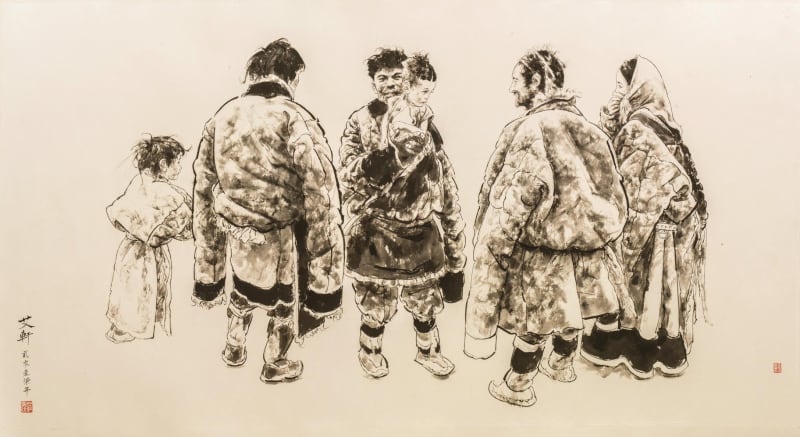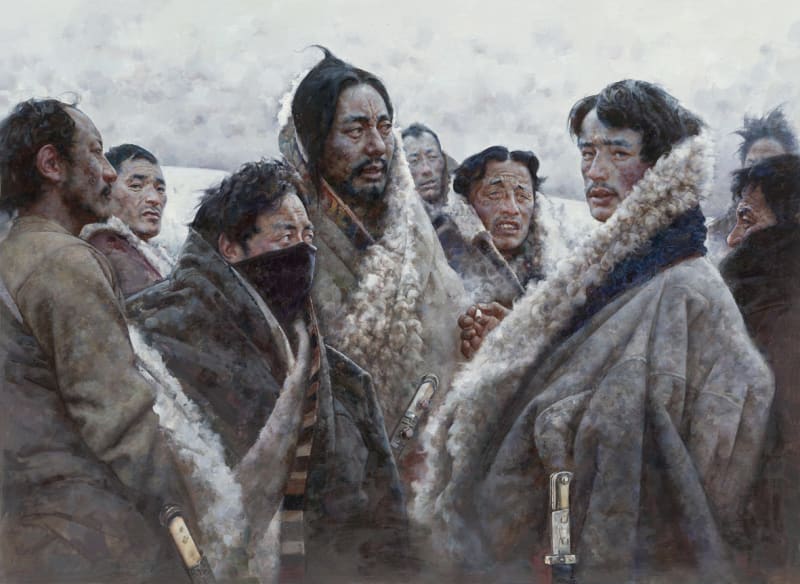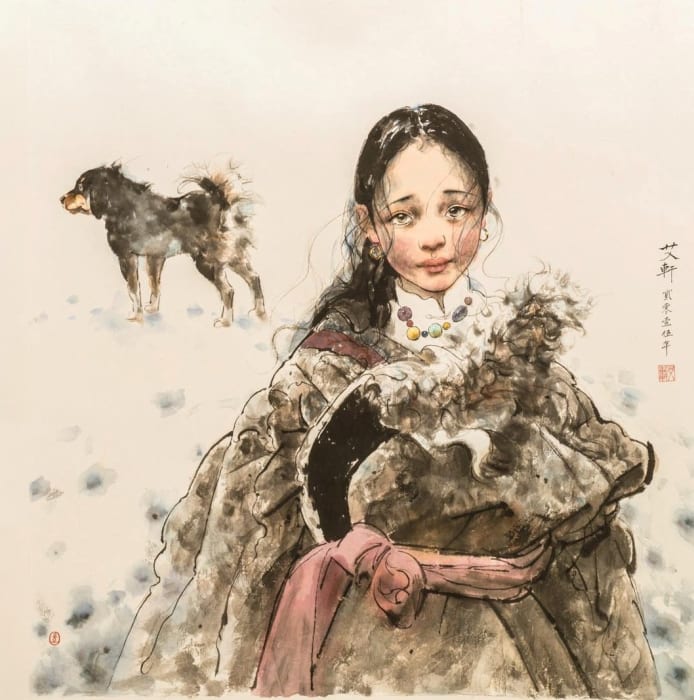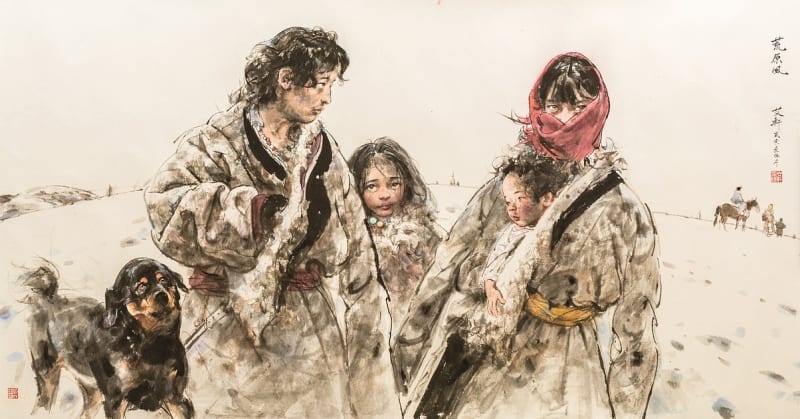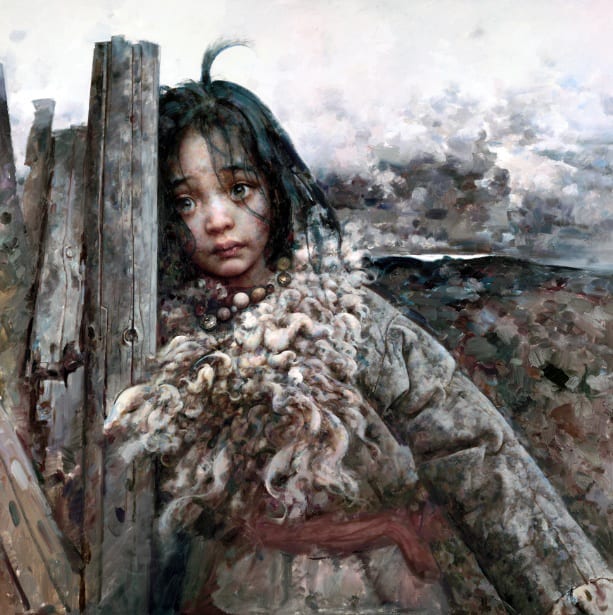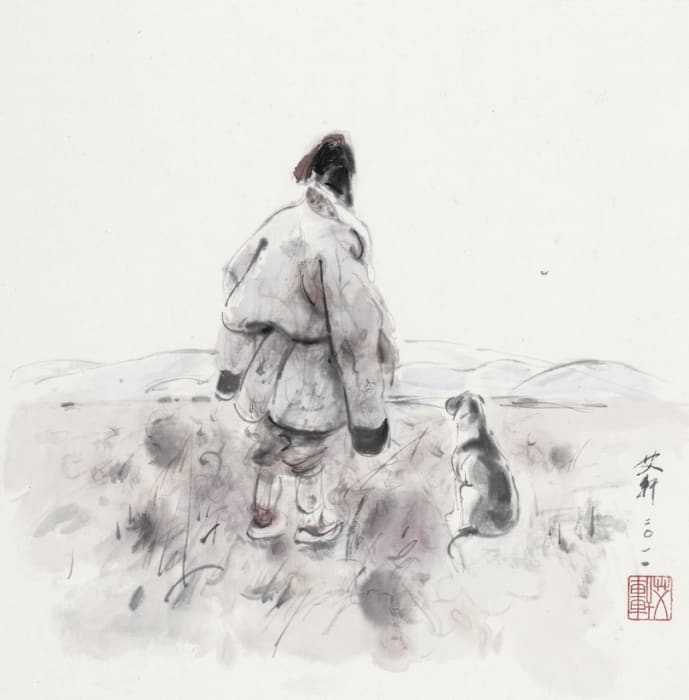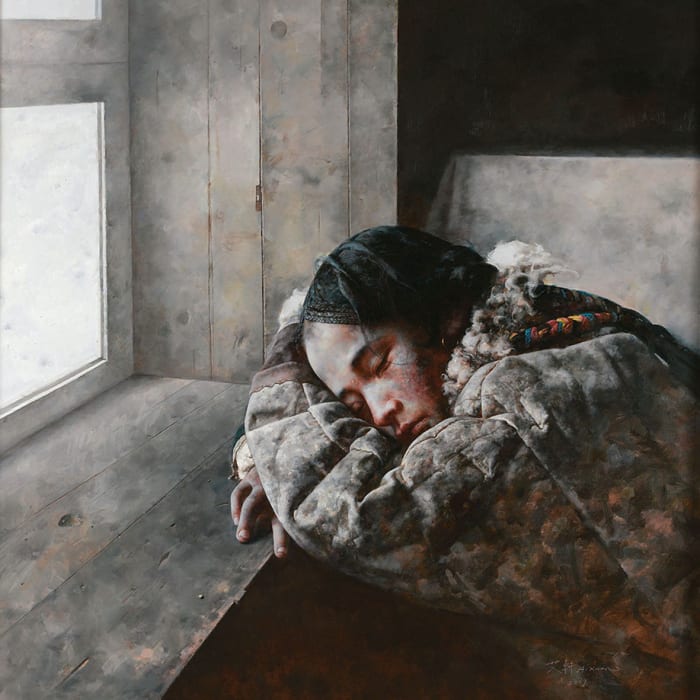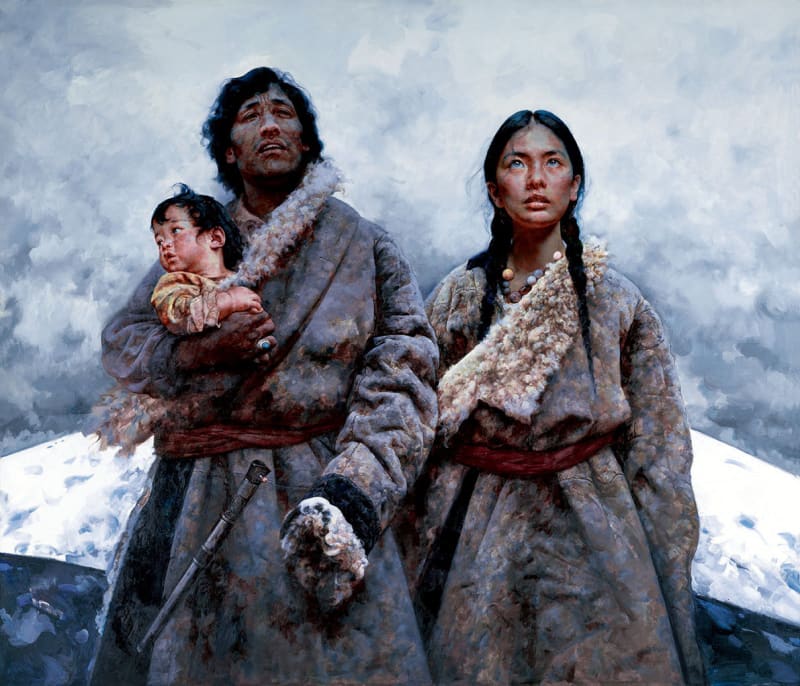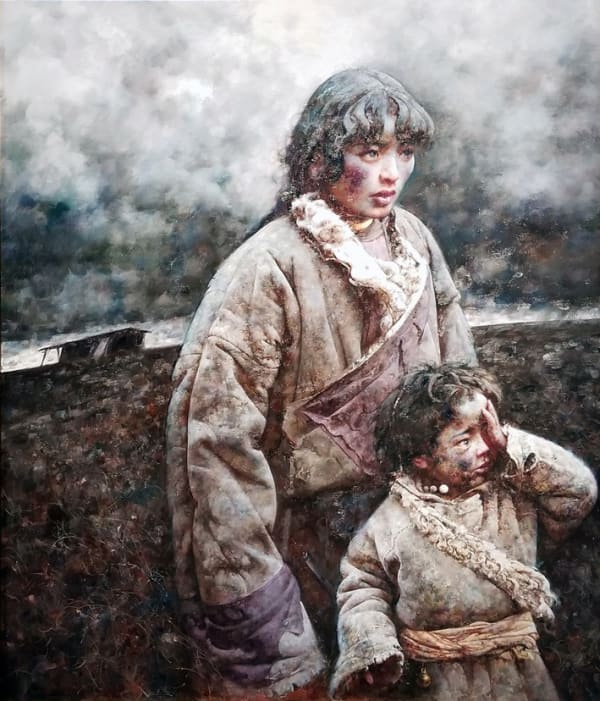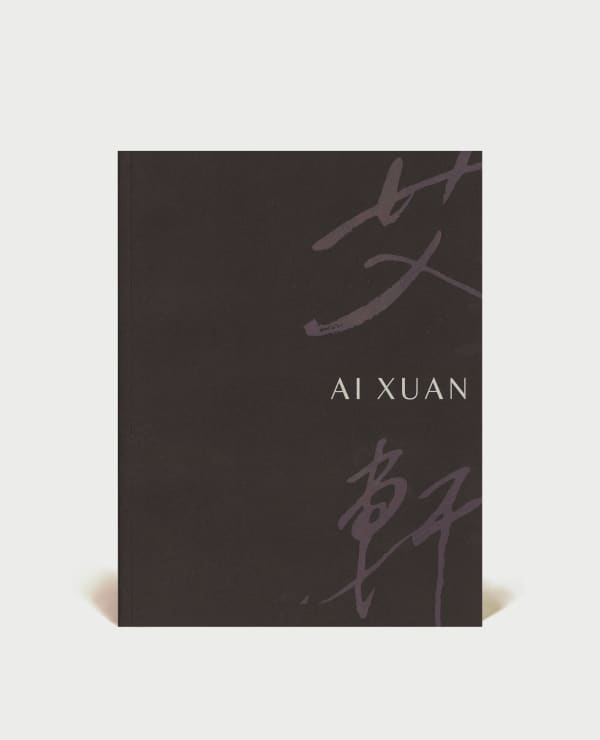Ai Xuan 艾 軒 b. 1947
Ai Xuan was born in 1947 to a family with its roots in Jinhua, a city in Zhejiang province in China. The son of poet Ai Qing, Ai studied at the Fine Arts Middle School affiliated to the Central Academy of Fine Arts during the turbulent Cultural Revolution. He is one of the founders of the School of Chinese Realism. With precise forms and delicate brushwork, his paintings reveal a depth of sadness, loneliness and emptiness that touches the soul.
Ai Xuan underwent a difficult childhood and adolescence, compounded by an unstable relationship between his parents that saw him sent back and forth from the nursery numerous times. In 1969, he was sent to Hebei to do hard labour, and resorted to painting in secret. In 1973, Ai Xuan was posted to Chengdu, Sichuan, to follow and record the daily life and deeds of the Red Army. That year, he encountered the Tibetan plateau in western Sichuan for the first time. Since then, Tibet and its people have become the subject of his paintings.
1981 ushered in a creative turning point for Ai Xuan. Interactions with his friend He Duoling and students from the Sichuan Fine Arts Institute changed his creative thinking, and he began to express personal emotions in his paintings. At the same time, Ai Xuan was moved by the melancholy poetic paintings of the American realist master Andrew Wyeth (1917-2009), prompting him to create his own realist style. After returning to Chengdu, his mind lingered on the scenery and people in Tibet who had sparked his artistic and spiritual curiosity. He frequently travelled to and from Tibetan areas and began to create works of Tibetan subjects in his distinctive style.
Since 2008, Ai Xuan has created ink paintings, still focused on Tibetan subjects. He incorporates the real-life experiences of the first half of his life into these paintings. From fine realistic oil paintings to freehand ink and wash presentations, his precise handling of line and space shows his exceptional realist modelling abilities, but his brush and ink works are more free and unrestrained, expressing the most authentic feelings in his heart through the simplest forms.
Ai Xuan's work is widely recognised. As early as 1986, he won the honorary award at the 18th Cagnes-Sur-Mer International Painting Festival. In 1999, Ai Xuan was included as one of the representative artists of modern Chinese Art in Professor Michael Sullivan's Art of China. In 2015, Ai Xuan was awarded the Chevalier Medal for Oriental Art by the Belgian Federal Parliament for his contribution to the cultural exchange between the East and the West. In the same year, he was awarded the European Art Star by the European Parliament. Ai Xuan's works have been widely collected by museums and private collectors in China and around the world, including the Metropolitan Museum of Art in New York, Fukuoka Asian Art Museum, the National Art Museum of China, Long Museum, Shanghai, the Song Art Museum in Beijing, and the Guy and Myriam Ullens Foundation.
-
 Let the Wind Blow the Song away 《就讓風把歌聲吹散》
Let the Wind Blow the Song away 《就讓風把歌聲吹散》 -
 White Light Fades Slowly 《白光慢慢滑落》
White Light Fades Slowly 《白光慢慢滑落》 -
 The Sacred Mountain 《聖山》
The Sacred Mountain 《聖山》 -
 Snow Falls on the Edge of Dream 《雪落在夢的邊緣》
Snow Falls on the Edge of Dream 《雪落在夢的邊緣》 -
 Tibetan Girl《凝視》, 1994.5
Tibetan Girl《凝視》, 1994.5 -
 Lonely Wanderer 《走遠的人》, 2014
Lonely Wanderer 《走遠的人》, 2014 -
 Warriors 《刀客》, 2016
Warriors 《刀客》, 2016 -
 Thunder from afar 《遠方的雷聲》, 2017
Thunder from afar 《遠方的雷聲》, 2017 -
 Cold Fog 《寒霧》, 2011
Cold Fog 《寒霧》, 2011 -
 Wind at Deserted Land《荒原風》, 2015
Wind at Deserted Land《荒原風》, 2015 -
 Still Frozen Land 《寂靜的凍土帶》, 2015
Still Frozen Land 《寂靜的凍土帶》, 2015 -
 Horse Market at Lhasa 《拉薩馬市》, 2017
Horse Market at Lhasa 《拉薩馬市》, 2017 -
 Meet-up at Lhasa 《拉薩偶遇》, 2017
Meet-up at Lhasa 《拉薩偶遇》, 2017 -
 Land with Story 《有故事的土地》, 2017
Land with Story 《有故事的土地》, 2017
'What I feel more is not the grandeur and the vastness [of Tibet], but the loneliness and insignificance of man. In the face of nature, man appears delicate, fragile, and helpless; he is so miniscule, it seems that he can only be consumed or extruded by the vast horizon afar.' Ai Xuan
1970s
In 1973, Ai Xuan was assigned to the creative team in the cultural division of the Chengdu Military Region in Sichuan as a military painter. At first he depicted the strong, healthy and progressive image of the Red Army, using the prevalent 'army style' of red, light and bright colours to create inspirational compositions quickly.
In 1974, accompanying the troops to the Ngaba Region in northwest Sichuan, Ai Xuan encountered Tibetan people for the first time. Their completely different cultural customs and the beautiful natural scenery came as a great shock. After multiple interactions, Ai Xuan established a deep relationship with the landscape and locals in Tibet, and produced a large number of life sketches of Sichuan and Tibetan culture.
1980s onwards
1981 was a turning point for Ai Xuan's artistic development. He won the second prize of the 'Second National Youth Art Exhibition' with his painting A Man of Great Will. He moved away from stylised propaganda paintings and developed the representative style of the Scar Art movement that emphasised life, humanity and the expression of inner emotions.
Afterwards Ai Xuan went to Sichuan and lived in the house of his friend He Duoling. He talked about literature and art with students from the Sichuan Fine Arts Institute, which inspired him to turn away the concept of theme-based painting, and instead pursue the expression of personal emotions, education and character in his works. In the Sichuan Fine Arts Institute libraries, Ai Xuan came across the paintings of Andrew Wyeth, a master of 'nostalgic realism' in the United States. This prompted Ai Xuan to create his own style of realism.
After returning to the Chengdu Military Region, Ai Xuan frequently visited the Tibetan area. The vastness and coldness of Tibet became the perfect way for Ai Xuan to express the emptiness and depression of his childhood and adolescence. This accumulation of feelings, coupled with his change of thinking after returning from the Sichuan Fine Arts Institute, enabled Ai Xuan to start his 'Tibet' series, using the realist depiction of the land and the inhabitants of Tibet to express his inner feelings. During this period, most of the figures in Ai Xuan's paintings were composed from the side or the back, so that the subjects themselves became the conduit for the painter's emotions in the landscape, whilst the scenery expressed his feelings.
'The most distinctive feature of Ai Xuan's style is his expression of sentiments through pictures of landscapes. He painted Tibetan plateaus and lonely people mainly to express his inner feelings. So, rather than saying that his works represent the Tibetan culture, it would be more accurate to say that his works are his personal monologues. As such, Ai Xuan's shadow can be found in every one of his paintings. In quietude and meditation, inexplicable loneliness is dispersed across the images of his models and the atmosphere of the painting.'
Shao Dazhen, art historian and critic
1990s onwards
Since the 1990s, Ai Xuan's Tibetan style gradually matured, and his paintings revealed a unique serenity and icy atmosphere. Qiong Bai, a Tibetan girl, began to appear as an important subject in his works. Her gaze, through a pair of pure, cool and crystal clear eyes, is sad and moving. This became his signature style, which has since been reinterpreted and intensified.
Ai Xuan painted little girls and young people. Sat or standing on the quiet and pure permafrost plateau, and staring at the sky with clear, bright, bewildered eyes, Ai Xuan observes the insignificance of human beings and their ill-fated destinies. The hardships of Ai Xuan's childhood and youth have become synonymous with the sad and tragic fate of Tibetan girls and young people in such a harsh environment.
The 21st century has seen Ai Xuan enter a period of steady integration after the maturation of his practice. He has tempered the rigorous training of the past half century with the nostalgia he learned from Andrew Wyeth and the sadness observed in the hardships of Tibetans on the snowy plateau, sublimating these experiences into a secluded and faraway realm that coexists with all things, is unified with heaven and earth, and at one with the universe.
'Another special characteristic of Ai Xuan's style is how he skillfully and beautifully combines the sentiments of loneliness and just a hint of mystery. The very nature of loneliness carries with it a certain mystique in the first place, so for the loneliness in the vast and desolate plains, the sense of mysteriousness is even more intense. But the artist has never ignored the beauty of either the people or the landscape. Even when he chooses to use a special composition to achieve unusual effects in the picture, the artist does not forget to satisfy the audience's aesthetic sense. Hence, Ai Xuan is using the charm of beauty to lead his audience into the world of art that is filled with religious emotions and with a mystifying atmosphere.'
Shao Dazhen, art historian and critic
2008 onwards
In 2008, Ai Xuan began to take his first steps in ink painting. The experiences of the first half of his life are integrated into ink and wash works that exude an unusual kind of subtle charm. The subject matter is still closely related to the spiritual outlook of Tibetan characters. After incorporating the elements of ink and wash painting, the style of these subjects naturally evolves between paper, pen and ink, becoming freer and more natural, with a blend of rigidity and softness.
In Ai Xuan's ink paintings, the relationship between human beings and reality is more blurred. Instead of provoking strong emotions in the viewer like oil paintings, they offer a more poetic view. The rich variations of ink and brush, developed realist modelling and use of blank space in the composition combine to bring out the faraway and distant recesses of the imagination. the brush and ink often show a fluffy hazy on the leather paper.
'Although the theme of Tibetan people and their customs remains, Ai Xuan's ink wash painting is different from conventional realist oil painting. There is a relaxing feeling in the natural interactions and movements between the brush, coloured ink and rice paper. Realist oil painting is like the 'hard', quick and sharp actions of Shaolin Kungfu, whereas ink wash painting is like the 'soft', slow and graceful movements of Taichi. Incorporating the two different disciplines allows the artist to exercise the most appropriate control. Ai's life in art has achieved a new milestone with a balance of both 'hard' and 'soft' disciplines after incorporating ink wash techniques…'
Hsiung Yi Ching, excerpt from Ai Xuan: Brush and Ink Absolutely Does Not Equal to Zero
-

The Cornerstone
An Exhibition Celebrating the 30th Anniversary of Kwai Fung 14 Jun - 31 Aug 2021Read more -

Soul is like Wind; Life is like snow - Recent Works of Ai Xuan
Kwai Fung Hin Art Gallery, G/F, 20 Ice House Street, Central, Hong Kong 27 Mar - 28 Apr 2018The exhibition will showcase Ai Xuan's latest works across various mediums, including three recently created oil paintings, seventeen ink works and eight drawings.Read more


